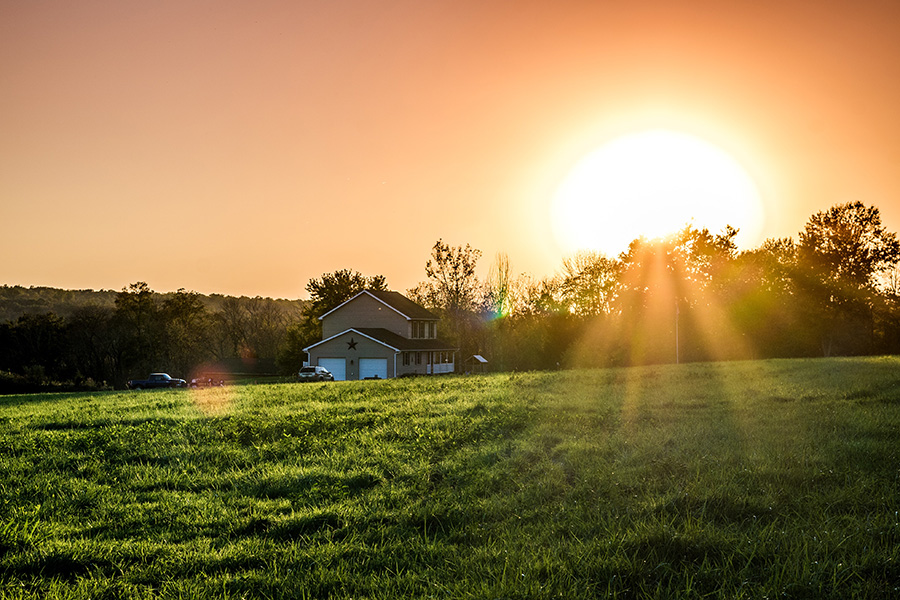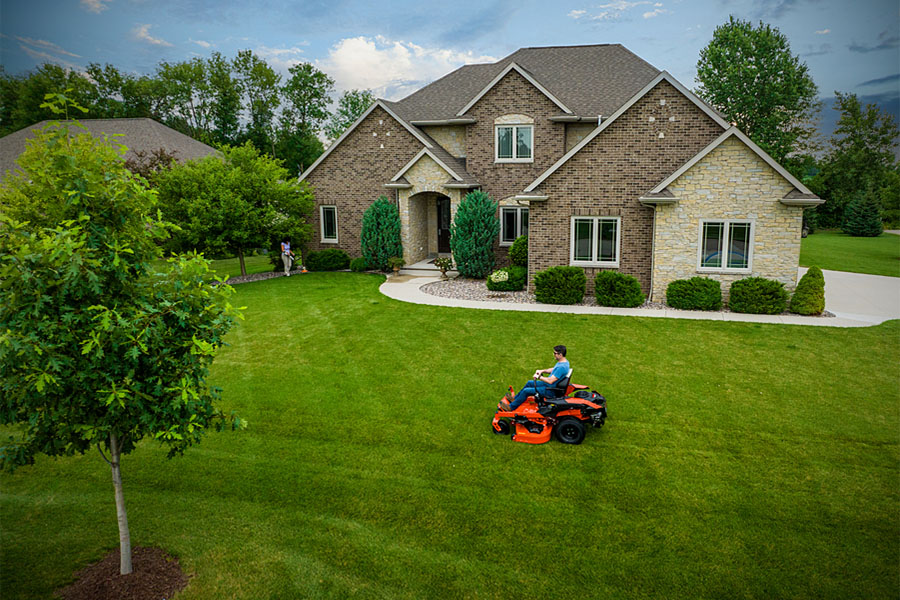Late Summer Lawn Care Tips
8/27/2023 10:52:00 AM
How to keep your grass healthy this summer
The solstice has long passed and the Earth’s axis is tilting back in a direction that will soon favor the Southern Hemisphere. Although summer and daylight hours are waning, there’s still plenty of heat to go around and a few more weeks to enjoy garden parties, barbeques, backyard sports and more with the family. The downside is that during this time of year, it’s drying out and our lawns aren’t as lush or soft as they were just a few weeks ago.

What can you do to keep your yard in prime condition so it remains a special place that you and your family can enjoy through the dog days of summer? It doesn’t require expensive equipment, contractors or even much of your time – all it takes is a touch of technique.
Watering your lawn correctly
Chances are, your lawn is receiving fewer regular soaking rains. Many parts of the country might not see rain for a week at a time or more, and in some parts, it’s dry enough that the grass is turning brown and feels painful to walk on with bare feet.
Though you can’t change the weather, you can fix a dry lawn.
How to tell if your grass needs watering
Your grass tells you that it needs water, even before it turns brown. When dehydrated, grass goes into conservation mode, folds its blades and shows its blue-green underside. If the color change isn’t enough to convince you that your grass needs water, walk on it and check if it springs back up in the path of your footprints. If those grass blades that were just walked on stay flat, it’s a sure sign that it’s time for a drink.
Inexpensive ways to water your lawn
The first thing that might come to mind when talking about lawn irrigation is one of those sophisticated irrigation systems that can be controlled from inside your home. Though these systems are efficient and highly effective, the installation of one may not align with your finances this year, and if not, that’s OK because you can still irrigate on a budget. In fact, you can pick up a high-quality hose and sprinkler set from your local department store for as little as $50. But among the many types of sprinkler systems to choose from, which is the right one for you?
The best lawn sprinklers
If we’re considering your time and the result, we’d suggest using an oscillating style sprinkler. Oscillating sprinklers are the type that spray water through small holes across the top of a gently arced tube with water supplied by a standard garden hose. As water pushes through the tube, the tube oscillates, creating even water dispersal across the range of the tube’s rotation, which is adjustable up to 180 degrees.
The benefit of an oscillating sprinkler is that they saturate a wide area evenly, which is not the case with all sprinkler types. Depending on the brand, oscillating sprinklers are advertised to cover up to 4,500 square feet of lawn at one time – meaning less time adjusting the sprinkler position and more time for yourself and your family. Simply drag the hose to the desired area, turn on the water and walk away. Position a container at each end of the sprinkler’s range and wait for it to collect about 1 to 1.5 inches of water, which is the general required weekly amount of water needed by your lawn. Once that area receives its weekly rations, move the sprinkler to the next area, wait for the containers to fill to their 1 to 1.5-inch mark and repeat until your entire lawn receives a good soaking.
To make the best use of your time, water just one area of your yard each day so you’re not spending your whole morning moving the sprinkler.
Oscillating sprinkler benefits:
- Covers a wide area
- Disperses water evenly
- Requires little effort or time from you
How much water does a lawn need?
Though a weekly dose of 1 to 1.5 inches of water above ground should give a lawn adequate moisture, it needs to penetrate at least six inches into the soil. Verify this by pushing a six-inch screwdriver shaft into the ground. If the whole length of the screwdriver pushes into the ground relatively effortlessly, your grass got enough water. If pushing the screwdriver into the ground requires even the slightest amount of force to insert it completely, turn the sprinkler back on.
The best time to water your lawn
Irrigating a lawn is least efficient during the day because the sun can evaporate a large amount of that water before it penetrates the soil and reaches the grass’s root systems.
Watering a lawn in the evening or at night, though cooler, isn’t the best time to irrigate a lawn, either. Watering at night when the air is still and temperatures stay cool for several hours keeps your lawn saturated longer than it needs to be. If you’re watering regularly at night, the little evaporation that occurs during these hours doesn’t allow your lawn to dry out properly, which can lead to fungal growth and lawn disease – especially during muggy and humid conditions.
Watering in the early morning is best. The sun angle is low and temperatures are cool enough for water to penetrate the soil, but the residual moisture doesn’t stick around long and evaporates shortly after the morning breeze rolls through and the sun reaches a higher angle.

Growing healthy grass roots
The deeper your grass’s roots, the more resilient they are to drought, disease and other conditions that can turn your beautiful lawn into the Addams family’s landscape.
How to grow healthy grass roots
Though we covered irrigation, it’s important to emphasise that proper watering leads to proper root length, and that helps grass survive dry periods. If a lawn is watered less frequently with deeper waterings, grass roots grow deeper. The deeper the roots, the stronger your grass’ ability to weather dry periods and stress.
Soil pH level
Another way to improve the health of your roots is by checking and correcting your soil’s pH level, or its measure of acidity or alkalinity. Most grass thrives with a soil pH of 6.5 to 7.0, which is in the slightly acidic to neutral range.
Testing your lawn's pH level can be done on your own with a testing kit from a gardening store. Test your soil by taking three to five soil samples from about 4 – 6 inches below the soil surface in different areas of your lawn. Remove the grass so you're sampling soil only. Mix the dirt together and spread around on a disposable surface so it can dry out over a 24-hour period and test according to the instructions of your kit.
If the soil is too acidic (pH 0 – 6), add wood ash to your lawn. It may take several applications over a few years to take effect, but it will put your roots on a track to becoming healthier. If the soil is too basic (pH 8 – 14), add sphagnum peat to your lawn. Just be aware that it may require some tilling to fully incorporate the sphagnum peat into the soil and for it to take effect. Another option is to add fine mulch and compost to your lawn.
The right way to cut your lawn

The shorter a lawn is cut, the shorter the roots will grow. Depending on the grass type that grows in your yard, you’ll likely cut a specific length for that breed, but consider raising your cutting height to encourage longer root growth. The longer grass grows at the top, the longer it’s growing underground and the better it will thrive.
The benefit of longer grass length is threefold because not only does grass become stronger and healthier, but the extra shade created by longer grass blades helps soil retain moisture and discourages weed growth.
Mower blade sharpness can also affect your lawn’s health. Dull blades tear grass and stress it even more than hot temperatures. That tearing and added stress can leave your lawn more susceptible to lawn disease, weed invasion or bug infestation, which is why it’s important to sharpen your blades regularly. If you don’t have the equipment or experience required to sharpen your blades, you can rely on your local Ariens dealer for help.
Aeration
Many of us have never given a second thought to aeration. Even the pickiest homeowners who appreciate a well manicured lawn may not even know what aeration is, let alone its benefits.
What is aeration?
Aeration is the plugging or coring of your soil, so literally pulling out small, but deep cores of soil from your lawn to help reduce soil compaction and improve air, water and nutrient exchanges with the grass roots. After a season of foot traffic, mower traffic and more across your lawn, the soil becomes compacted and the ability for those exchanges with the grass roots is reduced. Removing cores of soil through aeration creates space for compacted soils to loosen, which then improves access to grass roots.
Dethatching
Dead grass that falls to the soil bed and accumulates is called thatch. And though this thick layer of insulation has benefits for grass as the seasons change to fall and winter, too much thatch restricts water and nutrients from accessing your grass roots. Additionally, too much thatch can harbor bacteria and insects.
If excessive thatch builds up on your soil bed, it can be cleared with a rake, but if that’s going to cost more time than you’re willing, try using a dethatcher. Think of a dethatcher as a power rake. It’s a powered piece of equipment that uses a system of tines to pull dead grass away from the soil bed quickly and efficiently.
Avoiding lawn diseases
Like all living things, lawns are susceptible to illness and disease. It’s something many homeowners are completely unaware of but need to pay close attention to, especially at this time of year when warm weather creates an environment which allows pathogens to thrive. Fungus grows in conditions where grass is stressed, such as during times of drought, excessive rain and abnormal temperatures for warm and cool season grasses. If any of these conditions apply, be on the lookout for signs of a fungal infestation, because that’s the first step in preventing and fixing turf disease.
How to spot lawn disease
Of the many different fungal infections that can grow on a stressed lawn, most of them can be spotted easily. If you see circles or spots of wilted or withered brown, yellow, pale, pink or blackened colors in your lawn, it’s likely a sign of a fungal infection. It doesn’t take an expert to spot lawn disease; if your lawn is any color other than green, pay close attention and remedy the situation.
How to fix lawn disease
Stressed lawns become diseased and healthy lawns fight disease. To get rid of summer patch, dollar spot, brown patch or any other common lawn fungus, treat your soil’s pH level, fertilize, water correctly, seed, dethatch, aerate and mow with sharp blades and at an appropriate cutting height. The same procedures in avoiding lawn disease are the same ones used to cure it, too.
Taking care of your lawn while summer winds down is an important step to never miss. For more tips from the experts, check out our full blog page here.